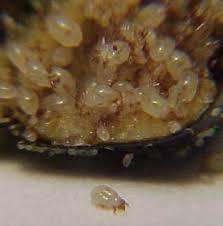Bulb mite Rhizoglyphus robini
Bulb mites attack bulbs and roots of many species, including Freesia, Gladiolus, hyacinth, lily, iris, Narcissus and tulips.
Bulb mites have an oval body shape (approx. 600-940 μm long) and are translucent with a shiny appearance. Their legs are short and reddish brown. Eggs are shiny, clear and oval shaped and are about 1/2 the size of the adult mite.
The mite generally attacks through basal plate of the bulb, or though the outer skin layers. If a bulb is bruised or damaged in any way, mite development occurs more quickly. If a bulb is infected with Fusarium rots, the time taken for mite establishment and development can be more than halved compared with that on healthy bulbs. Damage appears on the roots of Freesia and Gladiolus as dark brown streaks and the roots may also be "mined" internally. Healthy corms or bulbs grown in bulb mite infested soils will have distorted leaves and growing points. High numbers of bulb mites can quickly transform an entire bulb to a rotten pulp.
Bulb mites can be effectively controlled by Hypoaspis aculeifer.





